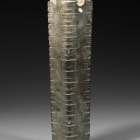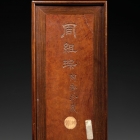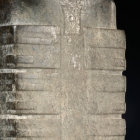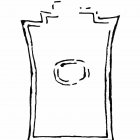J.J. Lally & Co., Oriental Art / New York City, New York
Menu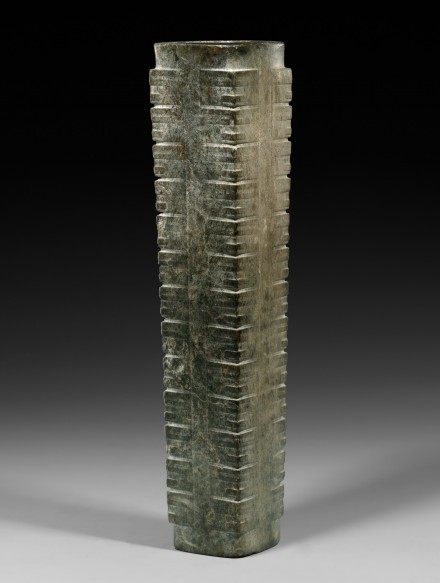
3.
A LARGE INSCRIBED NEOLITHIC JADE CONG
Liangzhu Culture, circa 3300 – 2250 B.C.
the tall block hollowed out as a cylinder of square cross section with thick walls, the slightly tapered sides divided into thirteen tiers of matching panels angled across the four corners and separated by deep grooves tapering back to the plain vertical band down the center of each side, each panel carved as a rudimentary mask with a pair of raised horizontal bars across the top above a shorter ‘nose’ bar with rounded ends flanked by two round ‘eyes’ very faintly incised on either side, with plain collars at either end, the upper collar faintly incised with a shield shaped emblem below the flat mouth rim, the stone of very dark green almost black color with degraded surface shading lighter in some areas; Chinese wood fitted box with brocade lining and inset burl wood panel bearing the carved inscription: Zhou Zu cong (周祖琮) Tao Zhai zhen cang (陶齋珍藏).
Height 12 7⁄8 inches (32.7 cm)
Provenance
From the Collection of Viceroy Duanfang (端方, 1861-1911)
From the Collection of Eugene Meyer (1875-1959) and
Agnes E. Meyer (1887-1970)
Chinese Neolithic jade carvings inscribed with an emblem are extremely rare. Most of the inscribed Chinese Neolithic jades were produced by the Liangzhu culture which flourished near Lake Tai and in the lower reaches of the Yangzi River valley, in parts of present day southern Jiangsu and northern Zhejiang provinces. Jade cong and bi discs were essential for ritual in the Liangzhu culture. Cong and bi have been found in large numbers in Liangzhu burials, but the great majority are not inscribed.
Less than twenty similarly inscribed Liangzhu Neolithic jades are recorded to date. Inscriptions are more frequently found on Neolithic jade bi. In addition to the present example only three other Liangzhu Neolithic cong bearing inscribed shield shaped emblems have been published.
A very similar Liangzhu jade cong of slightly smaller size in the Palace Museum, Beijing, carved with twelve tiers and inscribed with a shield shaped emblem below the upper rim, is illustrated by Gu (ed.), Zhongguo chuanshi yuqi quanji (Chinese Jades in Traditional Collections), Vol. 1, Neolithic Period, Shang, Western Zhou, Spring and Autumn Period, Warring States Period, Beijing, 2010, p. 33; compare also the taller Liangzhu jade cong in the Capital Museum, Beijing, inscribed with a shield shaped emblem, illustrated by Gu (ed.), op. cit., p. 35; and the smaller Liangzhu jade cong in the Musée Guimet, Paris, inscribed with a shield shaped emblem illustrated in a line drawing by Teng, “Incised Emblems on Ritual Jades of the Liangzhu Culture,” published in Yang (ed.), New Perspectives on China’s Past: Chinese Archaeology in the Twentieth Century, Volume I: Cultures and Civilizations Reconsidered, New Haven, 2004, p. 176, 6-5a.
新石器時代 良渚刻紋玉琮 高 32.7 厘米
出處 端方舊藏、邁爾夫婦舊藏
Additional Images (Touch to enlarge)
3.
A LARGE INSCRIBED NEOLITHIC JADE CONG
Liangzhu Culture, circa 3300 – 2250 B.C.
Height 12 7⁄8 inches (32.7 cm)
